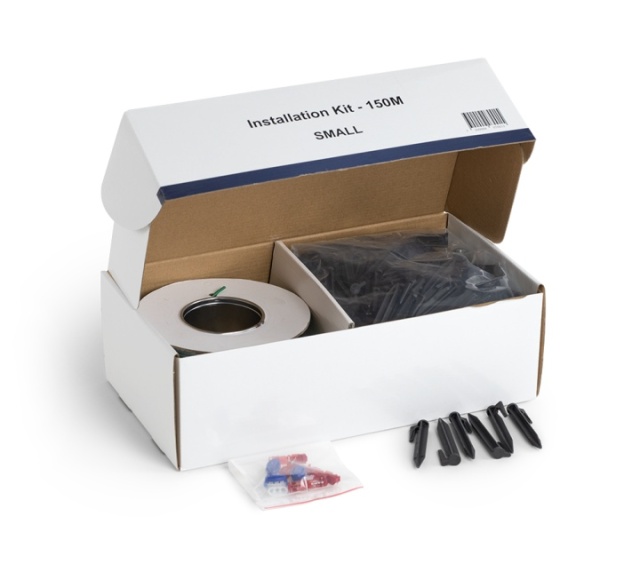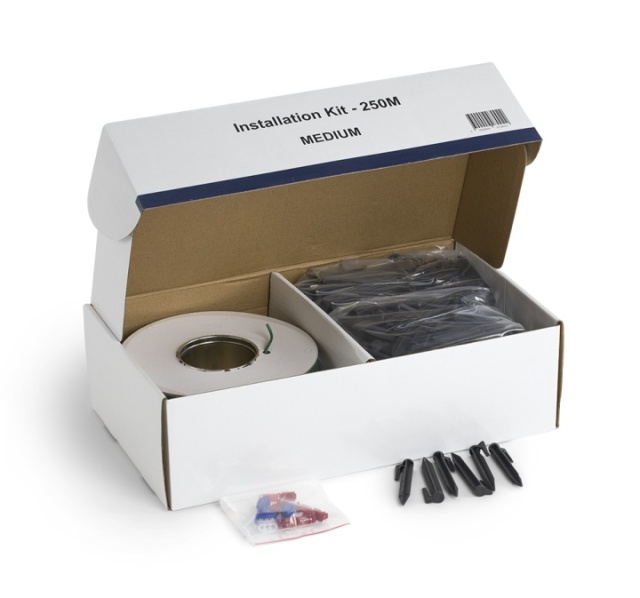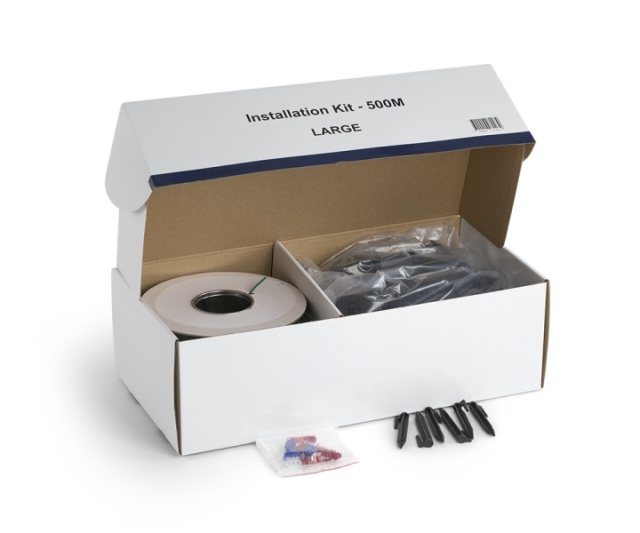What is a guide wire and what is its function?
When it comes to robotic lawnmowers, you often hear the terms "boundary wire" and "guide wire".
We would first like to point out and clarify that guide cables and boundary wires are physically the same type of cable. There is no special cable required to install the guide cable, but what makes them different is that you connect the different cables to different inputs in the charging station, giving them two different signals for the robotic lawnmower.
The boundary wireis often easy to understand – it is used to define the area in which the robotic lawnmower will move. So it is the cable that is at the border of the lawn, preventing the robot from moving outside this area. The vast majority of robotic lawnmowers on the market will not work without a boundary wire.
The guide cable has a completely different function – When the robotic lawnmower requires charging this wire guides the robot home.
The guide cable is a patented solution from Husqvarna but is also used by Gardena and McCulloch.
The advantage and purpose of a guide cable is to provide the shortest route back to the charging station. Instead of the robotic lawnmower having to follow the boundary wire all the way around the garden to the charging station, it uses the guide wire. It is therefore important that the guide wire is placed centrally, so that the robotic mower can find it as quickly as possible.
The second purpose is to guide the robotic lawnmower through narrow passages and to direct the robotic lawnmower to remote parts of the lawn.
An example of a well-placed guide cable
In the example below we have a rectangular shaped lawn with few obstacles. The boundary wire is placed around the plot boundary and an island has been created around the greenhouse. The guide cable then runs centrally from the charging station to the far end of the lawn. This is a well-placed guide cable. This location allows the robotic lawnmower, wherever it is, to easily find the guide wire within a reasonable time and easily make its way back to the charging station.
How is the guide cable connected?
Once the boundary wire is installed, it is time to install the guide wire.
There are certain requirements for how the guide cable should be installed; see below:
1. The guide cable should run for at least two metres in a straight line in front of the charging station before it branches off.
2. The guide cable must be at least 30 cm away from the boundary wire.
3. The guide cable must never cross a boundary wire, even if it is across an inner island.


Tip: To facilitate the connection of the guide cable to the boundary wire, it is recommended to create a loop with about 20 cm extra boundary wire at the place where the guide cable will later be connected.
Can I use multiple guide wires?
Some of the Husqvarna Automower® models have more than one guide wire connection. If your model has this feature, then utilising the advantage of two or three guide wires is an option.
Examples of models with one guide cable: The Automower® 105, Automower® 305, Automower® 310, Automower® 415X
Examples of models with two guide wires: The Automower® 420 (from2018), Automower® 430X
Examples of models with three guide wires: The Automower® 440, Automower® 450X.
Can I use the Automower® without a guide wire?*
The short answer is yes. Automower® can be used without a guide wire. But the time it takes for Automower® to find its way home will be much longer.
Although your Automower® model can operate without a guide wire, we always recommend installing one or more, depending on your model.
A guide cable shortens the search time, which in turn leads to less wear and tear, not only on the battery, but also on the wheel motors.
*Automower 105, 305 and 308 has to be used with a guide wire, otherwise they will not function correctly.
When it comes to robotic lawnmowers, you often hear the terms "boundary wire" and "guide wire".
We would first like to point out and clarify that guide cables and boundary wires are physically the same type of cable. There is no special cable required to install the guide cable, but what makes them different is that you connect the different cables to different inputs in the charging station, giving them two different signals for the robotic lawnmower.
The boundary wireis often easy to understand – it is used to define the area in which the robotic lawnmower will move. So it is the cable that is at the border of the lawn, preventing the robot from moving outside this area. The vast majority of robotic lawnmowers on the market will not work without a boundary wire.
The guide cable has a completely different function – When the robotic lawnmower requires charging this wire guides the robot home.
The guide cable is a patented solution from Husqvarna but is also used by Gardena and McCulloch.
The advantage and purpose of a guide cable is to provide the shortest route back to the charging station. Instead of the robotic lawnmower having to follow the boundary wire all the way around the garden to the charging station, it uses the guide wire. It is therefore important that the guide wire is placed centrally, so that the robotic mower can find it as quickly as possible.
The second purpose is to guide the robotic lawnmower through narrow passages and to direct the robotic lawnmower to remote parts of the lawn.
An example of a well-placed guide cable
In the example below we have a rectangular shaped lawn with few obstacles. The boundary wire is placed around the plot boundary and an island has been created around the greenhouse. The guide cable then runs centrally from the charging station to the far end of the lawn. This is a well-placed guide cable. This location allows the robotic lawnmower, wherever it is, to easily find the guide wire within a reasonable time and easily make its way back to the charging station.
How is the guide cable connected?
Once the boundary wire is installed, it is time to install the guide wire.
There are certain requirements for how the guide cable should be installed; see below:
1. The guide cable should run for at least two metres in a straight line in front of the charging station before it branches off.
2. The guide cable must be at least 30 cm away from the boundary wire.
3. The guide cable must never cross a boundary wire, even if it is across an inner island.


Tip: To facilitate the connection of the guide cable to the boundary wire, it is recommended to create a loop with about 20 cm extra boundary wire at the place where the guide cable will later be connected.
Can I use multiple guide wires?
Some of the Husqvarna Automower® models have more than one guide wire connection. If your model has this feature, then utilising the advantage of two or three guide wires is an option.
Examples of models with one guide cable: The Automower® 105, Automower® 305, Automower® 310, Automower® 415X
Examples of models with two guide wires: The Automower® 420 (from2018), Automower® 430X
Examples of models with three guide wires: The Automower® 440, Automower® 450X.
Can I use the Automower® without a guide wire?*
The short answer is yes. Automower® can be used without a guide wire. But the time it takes for Automower® to find its way home will be much longer.
Although your Automower® model can operate without a guide wire, we always recommend installing one or more, depending on your model.
A guide cable shortens the search time, which in turn leads to less wear and tear, not only on the battery, but also on the wheel motors.
*Automower 105, 305 and 308 has to be used with a guide wire, otherwise they will not function correctly.
What is a guide wire and what is its function?
When it comes to robotic lawnmowers, you often hear the terms "boundary wire" and "guide wire".
We would first like to point out and clarify that guide cables and boundary wires are physically the same type of cable. There is no special cable required to install the guide cable, but what makes them different is that you connect the different cables to different inputs in the charging station, giving them two different signals for the robotic lawnmower.
The boundary wireis often easy to understand – it is used to define the area in which the robotic lawnmower will move. So it is the cable that is at the border of the lawn, preventing the robot from moving outside this area. The vast majority of robotic lawnmowers on the market will not work without a boundary wire.
The guide cable has a completely different function – When the robotic lawnmower requires charging this wire guides the robot home.
The guide cable is a patented solution from Husqvarna but is also used by Gardena and McCulloch.
The advantage and purpose of a guide cable is to provide the shortest route back to the charging station. Instead of the robotic lawnmower having to follow the boundary wire all the way around the garden to the charging station, it uses the guide wire. It is therefore important that the guide wire is placed centrally, so that the robotic mower can find it as quickly as possible.
The second purpose is to guide the robotic lawnmower through narrow passages and to direct the robotic lawnmower to remote parts of the lawn.
An example of a well-placed guide cable
In the example below we have a rectangular shaped lawn with few obstacles. The boundary wire is placed around the plot boundary and an island has been created around the greenhouse. The guide cable then runs centrally from the charging station to the far end of the lawn. This is a well-placed guide cable. This location allows the robotic lawnmower, wherever it is, to easily find the guide wire within a reasonable time and easily make its way back to the charging station.
How is the guide cable connected?
Once the boundary wire is installed, it is time to install the guide wire.
There are certain requirements for how the guide cable should be installed; see below:
1. The guide cable should run for at least two metres in a straight line in front of the charging station before it branches off.
2. The guide cable must be at least 30 cm away from the boundary wire.
3. The guide cable must never cross a boundary wire, even if it is across an inner island.


Tip: To facilitate the connection of the guide cable to the boundary wire, it is recommended to create a loop with about 20 cm extra boundary wire at the place where the guide cable will later be connected.
Can I use multiple guide wires?
Some of the Husqvarna Automower® models have more than one guide wire connection. If your model has this feature, then utilising the advantage of two or three guide wires is an option.
Examples of models with one guide cable: The Automower® 105, Automower® 305, Automower® 310, Automower® 415X
Examples of models with two guide wires: The Automower® 420 (from2018), Automower® 430X
Examples of models with three guide wires: The Automower® 440, Automower® 450X.
Can I use the Automower® without a guide wire?*
The short answer is yes. Automower® can be used without a guide wire. But the time it takes for Automower® to find its way home will be much longer.
Although your Automower® model can operate without a guide wire, we always recommend installing one or more, depending on your model.
A guide cable shortens the search time, which in turn leads to less wear and tear, not only on the battery, but also on the wheel motors.
*Automower 105, 305 and 308 has to be used with a guide wire, otherwise they will not function correctly.
When it comes to robotic lawnmowers, you often hear the terms "boundary wire" and "guide wire".
We would first like to point out and clarify that guide cables and boundary wires are physically the same type of cable. There is no special cable required to install the guide cable, but what makes them different is that you connect the different cables to different inputs in the charging station, giving them two different signals for the robotic lawnmower.
The boundary wireis often easy to understand – it is used to define the area in which the robotic lawnmower will move. So it is the cable that is at the border of the lawn, preventing the robot from moving outside this area. The vast majority of robotic lawnmowers on the market will not work without a boundary wire.
The guide cable has a completely different function – When the robotic lawnmower requires charging this wire guides the robot home.
The guide cable is a patented solution from Husqvarna but is also used by Gardena and McCulloch.
The advantage and purpose of a guide cable is to provide the shortest route back to the charging station. Instead of the robotic lawnmower having to follow the boundary wire all the way around the garden to the charging station, it uses the guide wire. It is therefore important that the guide wire is placed centrally, so that the robotic mower can find it as quickly as possible.
The second purpose is to guide the robotic lawnmower through narrow passages and to direct the robotic lawnmower to remote parts of the lawn.
An example of a well-placed guide cable
In the example below we have a rectangular shaped lawn with few obstacles. The boundary wire is placed around the plot boundary and an island has been created around the greenhouse. The guide cable then runs centrally from the charging station to the far end of the lawn. This is a well-placed guide cable. This location allows the robotic lawnmower, wherever it is, to easily find the guide wire within a reasonable time and easily make its way back to the charging station.
How is the guide cable connected?
Once the boundary wire is installed, it is time to install the guide wire.
There are certain requirements for how the guide cable should be installed; see below:
1. The guide cable should run for at least two metres in a straight line in front of the charging station before it branches off.
2. The guide cable must be at least 30 cm away from the boundary wire.
3. The guide cable must never cross a boundary wire, even if it is across an inner island.


Tip: To facilitate the connection of the guide cable to the boundary wire, it is recommended to create a loop with about 20 cm extra boundary wire at the place where the guide cable will later be connected.
Can I use multiple guide wires?
Some of the Husqvarna Automower® models have more than one guide wire connection. If your model has this feature, then utilising the advantage of two or three guide wires is an option.
Examples of models with one guide cable: The Automower® 105, Automower® 305, Automower® 310, Automower® 415X
Examples of models with two guide wires: The Automower® 420 (from2018), Automower® 430X
Examples of models with three guide wires: The Automower® 440, Automower® 450X.
Can I use the Automower® without a guide wire?*
The short answer is yes. Automower® can be used without a guide wire. But the time it takes for Automower® to find its way home will be much longer.
Although your Automower® model can operate without a guide wire, we always recommend installing one or more, depending on your model.
A guide cable shortens the search time, which in turn leads to less wear and tear, not only on the battery, but also on the wheel motors.
*Automower 105, 305 and 308 has to be used with a guide wire, otherwise they will not function correctly.




 Help center is a digital DIY manual for Husqvarna Automower robotic lawnmower. We teach you how to change batteries, circuitboards and other spare parts on your Husqvarna Automower.
Help center is a digital DIY manual for Husqvarna Automower robotic lawnmower. We teach you how to change batteries, circuitboards and other spare parts on your Husqvarna Automower.